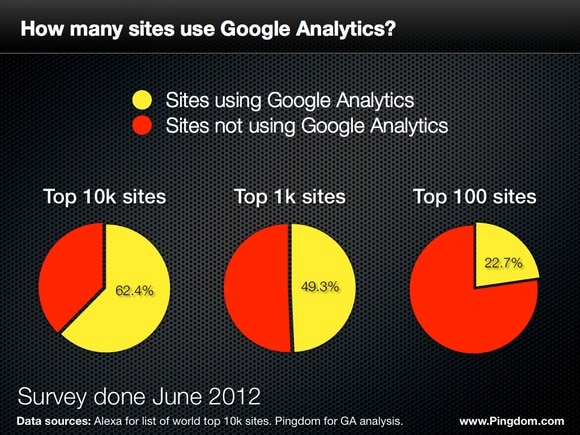 When Google bought Urchin Software in 2005 and released its Urchin on Demand service for free to the entire Internet, the company transformed the web analytics industry forever. All of a sudden there was a powerful yet completely free option available for everyone. Webmasters have rallied to Google Analytics ever since, and as of June this year, 62.4% of the top 10,000 websites use the service.
When Google bought Urchin Software in 2005 and released its Urchin on Demand service for free to the entire Internet, the company transformed the web analytics industry forever. All of a sudden there was a powerful yet completely free option available for everyone. Webmasters have rallied to Google Analytics ever since, and as of June this year, 62.4% of the top 10,000 websites use the service.
That kind of market share is quite amazing, and it’s safe to say that Google Analytics is one of Google’s biggest triumphs. Really, the numbers speak for themselves.

A growing dominance
Being a both free and powerful analytics package, Google Analytics has become a huge success for Google. It’s popularity is undeniable, and this survey shows that the number of sites that use Google Analytics keeps growing.
In 2009, 50% of the top 10,000 websites on the Internet used Google Analytics, which as we just showed you has now gone up to 62.4%. Or put another way, Google Analytics usage among the top 10k sites is up 24.8% since 2009.
And there is more. Back in 2008 we showed that 32.2% of the top 500 websites on the Internet used Google Analytics. That number has now risen to 39.4%. That’s a 22.4% increase in Google Analytics usage among the top 500 sites since 2008.
New script versus old script
Interestingly, we noticed that 6.5% of the sites with Google Analytics are still not using the new ga.js script that Google introduced in December of 2007, instead relying on the old urchin.js script. That means these sites are not reaping the full benefit of Google Analytics. We’re not even sure that script works properly anymore, having been deprecated almost five years ago.
On the other hand, three years ago almost half of the top 10,000 sites were still clinging on to the old script, so the situation is much better now than it used to be. Webmasters have caught on and mostly gotten with the program.
We also found that a small number of sites actually had both scripts on their page. Just under 0.9% of the sites using Google Analytics fall into this category. We’ll just assume that this is an oversight.
Up, up and away
It’s clear that Google really values the Analytics product, and has launched a number of improvements to the service over the years. Just this past year, Google introduced a new control panel, user flow visualizations, and even a real-time dashboard, perhaps in response to the popularity of services such as Chartbeat.
Then there is the price. Free is hard to beat. And it’s not like Google is peddling a bad product here, either. Google Analytics has a ton of excellent features, and it’s the kind of product that every webmaster needs.
There obviously is a market for other paid analytics services since they keep popping up, but that market became much smaller and more niche the day Google introduced Analytics. And each day that passes, Google’s slice of that pie gets a little bit bigger.
Methodology: We scanned for the inclusion of either “/ga.js” or “/urchin.js” in the HTML code of the homepages of the top 10k sites on the Internet (as per Alexa).
Here is a larger version of the chart, for those of you so inclined.
























